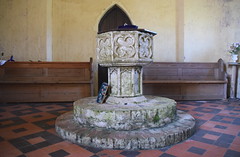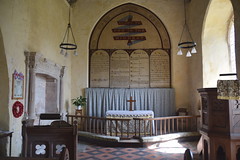| |
|
St John,
Waxham Ah, the crumbling
churches of north-east Norfolk! To have come here in the
mid-19th century would have been to do a journey through
ruins, but slowly they were mostly patched up during the
years that turned into the 20th century. Now, Sea Palling
is as spick and span as a new pin, Mundesley and
Sidestrand are full of the feeling of the Anglo-catholic
revival, and up in Sheringham and Cromer there are fine,
urban churches where once were haunted shells.
But some were restored more enthusiastically than others,
and to get a feel for what once was, the edginess of a
coastal church near to falling down, you need to come to
Waxham.
Even without the church, there is a feeling that this is
an ancient place. Waxham Hall next door was the home of
the Woodhouses and then the Calthorpes, and in the late
16th century the first of these two families built the
massive Waxham Great Barn, the village's most famous
building. It is the biggest barn in East Anglia, and was
probably intended as such to compete with the Paston
Great Barn further up the coast, a show of conspicuous
consumption. It is a grade I listed building, and you can
visit it.
On this day in high summer, the church floated like a
ship in the dusty graveyard, and the roads all around
were clogged with holidaymakers' cars, parked here so
that they could walk across the dunes to the beach below.
And, despite its ancient buildings, Waxham does feel as
if it is tenuous, and on the edge. The soil is sandy, and
beyond the slight village the land dissolves into a
rolling greenness intercut with drains, the sea wall
beyond.
The chancel here was derelict shortly after the
Reformation, and the tower looks as if it had intentions
of going the same way. The relief is weathered, the
features eroded, and the west window long since filled in
with red bricks which are themselves beginning to erode
and fade. You step into an interior which is charmingly
simple. It could be that of a non-conformist chapel. The
tower arch has been completely blocked off. The font is
covered in green damp, and the Victorian floor tiles echo
a jolly, painted roof. The chancel arch has been filled
in with decalogue boards and a Victorian tin tympanum
reminding us to give Glory to God in the Highest. There
is a large late 16th memorial in the north wall with a
painted inscription to Thomas Wodehouse, who built the
great barn. Not far off is another banner stave locker
like that at Sea Palling.
The walls are plain and creamy, with echoes of past
openings now melting like ice cream. An intriguing little
space, quite different to the glories of the neighbouring
Hall and the restored Great Barn, with an atmosphere all
of its own, and worth a visit for that alone.
Simon Knott, September 2019
Follow these journeys as they happen at Last Of England
Twitter.
  
  
|
|
|
